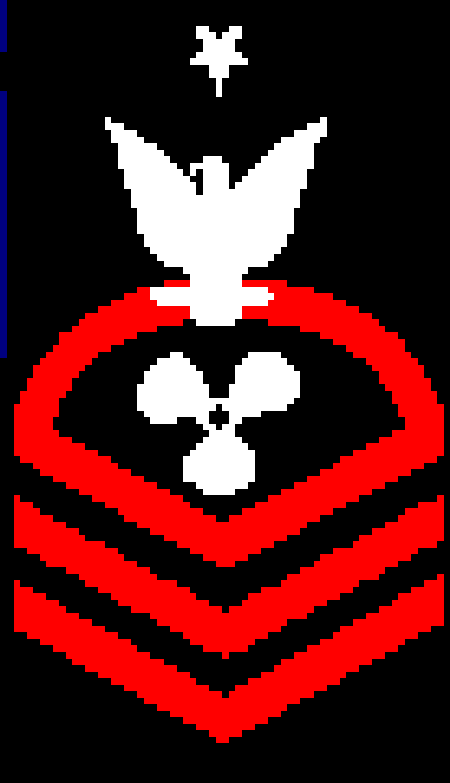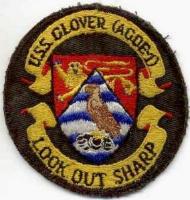 |
|
|
 |
 |
|
Click for photos |
 |
|
 |
|
|
| A modified GARCIA (FF-1040)-class Fast Frigate
Built by: Bath Iron Works; Bath, Maine (construction began in 1963) Commissioned: April 17, 1965 Length: 414 feet Beam: 44 feet Displacement: 3635 tons (full load) Draft: 26 feet Power Plant: Two, 1200 psi, 950 degrees F, pressure-fired boilers Shaft horsepower: 35,000 Shafts: One Maximum speed: 27 knots Air search radar: AN/SPS-40 Surface search radar: AN/SPS-10 Sonar: AN/SQS-26 AX (R) Variable depth sonar: AN/SQS-35V Armament: ASROC (from one MK-16 launcher); Six MK-46 torpedoes (from two triple-mount MK-32 tubes, one on each side of ship); One 5inch/38 caliber MK-30 gun Fire control: GFCS MK-56 and ASW FCS MK-114 Complement: 21 officer and 235 enlisted men Decommissioned: January 1, 1993 |
|
|
| Glover was modified to
serve as an anti-submarine warfare (ASW) research and development platform
to test various shipboard systems. Originally commissioned as AGDE-1,
she was redesignated AGFF-1 on July 13, 1975. Glover
was equipped with the most advanced ASW equipment available and was designed
from the beginning to be quieter than existing surface ships, and was built
with shock-mounted machinery, noise- masking equipment, fin stabilizers,
and pump jet propulsion instead of the usual propellor. (Note:
This mode of propulsion features a destroyer screw that has had its diameter
shortened then a shroud put around it. This reduces cavitation of
the screw and thus noise.)
Because her primary mission was testing and evaluating advanced equipment, Glover seldom operated as a full fleet asset. This role gradually changed as Glover began participating in an increasing number of fleet exercises. In keeping with her changing role, Glover changed homeport from Newport, Rhode Island to Norfolk, Virginia in 1974. She completed her first deployment in 1978, returned from the Middle East on September 1st. |
| On September 7, 1979, Glover left on her second deployment to the Middle East, and her last as AGFF-1. On October 1, 1979, transiting the Red Sea enroute to Djibouti, Djibouti, her designation was changed to FF-1098 (the hull number of a canceled KNOX-class Fast Frigate). |
| Not long after returning from the Middle East, Glover became one of the first (if not the first) combatant ships to have women serve aboard. As an ex-research and development vessel, she had a special berthing section that had once been used for civilian technicians during the testing of various new components. This was probably the main reason she was picked for this program. One female Navy Lieutenant from the U.S. Naval Academy and four fourth-year female midshipmen were assigned for a couple of months. During their time aboard, they interacted well with the crew and got to learn about every aspect of the ship. Their time aboard was a definite success. |
| Glover entered overhaul at the Norfolk Naval Shipyard in Portsmouth, Virginia in August 1980. After completion of overhaul, Glover participated in READEX 3-82. She deployed in November 1982 as part of MED 1-83. She conducted Special Operations (SPECOPS) off Central America from August 1983 to October 1983. Glover participated in Ocean Venture 84 after which she sailed for Northern Europe to act as the U.S. representative for the International Navy Festival in Kiel, Germany. In December 1984, Glover returned to the Caribbean to display U.S. presence in Central America. During the first half of 1985, Glover played a major role in two fleet exercises, READEX 1-85 and Solid Shield 85. |
| The following is from Glenn
Gavan, LT (WEPS), 1986-1990: In the winter of 1986 Glover
was part of the Caribbean drug intervention program. She sailed throughout
the Caribbean, stopping and searching vessels that met the profile for
drug-running vessels. In the spring of 1987 she again left for the North
Atlantic, with stops in Halifax, Nova Scotia; Teneuzen, Netherlands; Kiel,
West Germany (again acting as the U.S. representative in the Kiel week
Festival), Portland, England; Edinburgh, Scotland; Kristiansand, Norway;
Portsmouth, England ( where Glover was the
first U.S. ship to take part in Royal Navy Damage Control training); and
a visit to Marblehead. Upon returning to Norfolk, a short notice
off-load of all ASROCs was made and an upgraded ASROC launcher was installed.
Glover then went to Charleston, SC to enter drydock to have the bow-mounted sonar removed and an experimental array installed with a brand new rubber window. After this was completed she spent many weeks at sea again testing state-of-the-art sonar. She then entered drydock in Boston for an extensive overhaul. After some 11 months, she left for GITMO and REFTRA. Then back to sea with a brand new experimental towed-array system for many hours of submarine tracking and experiments. In May of 1990 she was redesignated as part of the USNS fleet and located out of Groton, CT until her decommissioning in 1993. |
| Glover was named in honor
of General John Glover, a Revolutionary War general, who donated the sloop
HANNAH (a ship in the small fleet that helped General George Washington
in the siege of Boston) to Washington, as the first warship of the U.S.
Navy. General Glover was from the town of Marblehead, Massachusetts,
and in 1967, Marblehead adopted the ship. Since then
Glover
returned for many enjoyable visits.
Glover's coat of arms (see patch at top of this page) commemorates the exploits of General Glover. The gloved hand alludes to John Glover and bearing a falcon, a bird used for attack, symbolizes the ferrying of General Washington and his troops across the Delaware. Glover's motto, "LOOK OUT SHARP," is taken from the sign and countersign used by Washington's troops as they crossed the Delaware. |
 |
|
|
| I reported aboard Glover at the D&S Piers in Norfolk, Virginia as a Chief Machinist's Mate on October 16, 1978, after being tranferred from USS Dwight D. Eisenhower (CVN-69). As an MMC (and a selectee to MMCS), I was assigned to take over the 16-man M-Division. I was advanced to Senior Chief Machinist's Mate in March 1979. |
| On November 28, 1979, underway in the Indian Ocean from Karachi, Pakistan to Mombasa, Kenya, I finally became a Shellback (as an E-8 with 19 years and six months in the Navy. . . click on the link below). The men in my division who were Shellbacks really loved initiating me. A few days before, I had volunteered to be the division's candidate for Royal Dog (I lost). |
| On our way back from the Middle East three other men and I received the breast insignia asEnlisted Surface Warfare Specialists (ESWS) (see pin at the top of this page). The CO had placed me in charge of implementing the ESWS qualification program on the ship due to my being a submariner and an ex-nuke. We were some of the first men in the Navy to receive this qualification. |
| In May 1980, as the senior enlisted man aboard, I was designated as the Command Senior Chief (see pin to the right above). |
| Six days before I was to retire from the Navy, I found out that I'd been selected for advancement to Master Chief Machinist's Mate. Since I was 80 out of 81 MMCMs in that advancement cycle, my official advancement would not have taken place until June 16, 1982. At that time, MMCMs were on a three year at sea, three on shore duty cycle. I was eligible for shore duty at the time I was going to retire and since there was no place I wanted to go (and not wanting to go back to sea after shore duty) I went ahead and retired. I transferred to the Fleet Reserve on April 30, 1981. |
|
|
|
|
|
|
|
|
|
|
|
|
|
|
| Fleet Reserve Association The hardest-charging military lobby group there is (especially for enlisted-related matters) |
| National Chief Petty Officers Association (NCPOA) Iím a member |
| The Retired Enlisted Association (TREA) Iím a member |
| U.S. Navy Memorial Every Navy veteran should have his particulars in the Navy Log (it's accessible on-line) |
| Bluejacket.com Informative site on USN, USMC, USCG history and traditions |
|
|
|
|
|
|